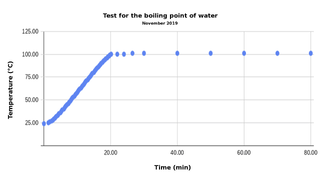Test for boiling point
To establish the boiling point of a material, that material is placed in a refluxing apparatus, and a thermometer is immersed directly in the material. A constant heat is applied, and the temperature of the material is recorded and graphed as a function of time. The shape of the curve (specifically the plateau temperature reached) indicates the boiling point of the material being tested
Nature
Once a material in its liquid form has reached its boiling point, any additional (heat) energy added to it vaporizes the material, converting it from liquid to gas. The liquid itself cannot rise above the boiling point of the material. Thus, in a reflux apparatus, the temperature will rise relatively steadily until the boiling point is reached, and will remain at that temperature so long as sufficient heat is applied to keep it at that temperature.
The graph will therefor appear as an S-shaped cubic monotonically increasing function that reaches a maximum value and remains at that temperature over a considerable amount of time, indicating that the boiling point has been reached.
Equipment
- Refluxing setup, with either a passive or active condensing element.
- A heating element capable of applying a steady heat over a long enough period of time to reach the boiling point and keep the material at that temperature for some time.
- A thermometer capable of measuring temperatures above and below the boiling point of the material
Execution
Example
The graph at the right shows a test for the boiling point of water. Note that these results are for that location at local ambient pressure. The curve at the left shows an initial delay as the test equipment reaches a steady state. Then follows a very linear 3.75° per minute increase over about 20 minutes to 100°. After another 5 minutes the temperature reaches 101°C and remains there for an hour, despite steady heating. This shows that the boiling point is near the 100/101°C level, as would be expected for water.
